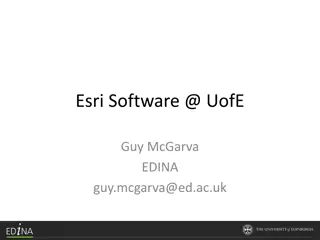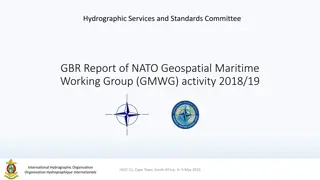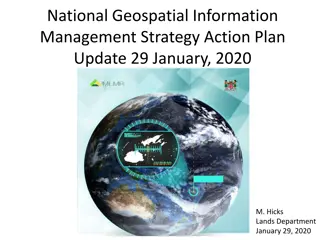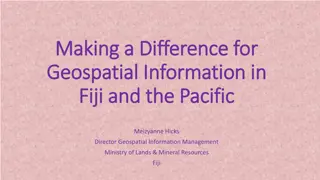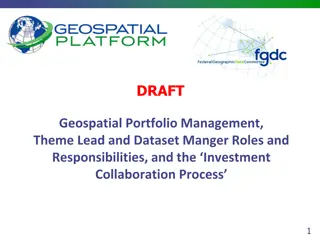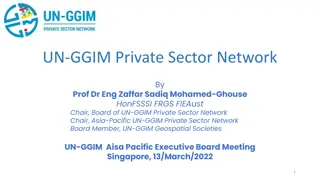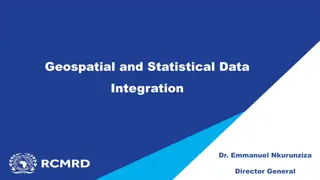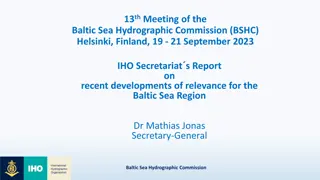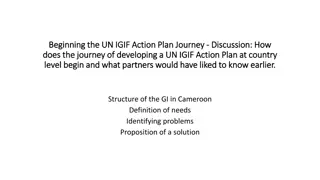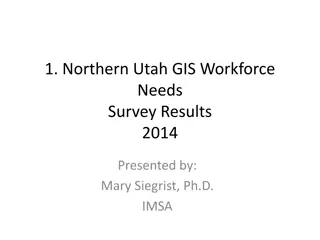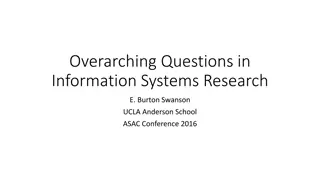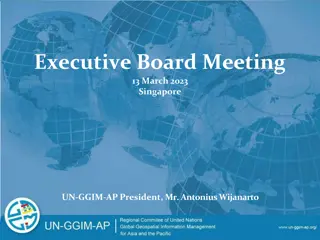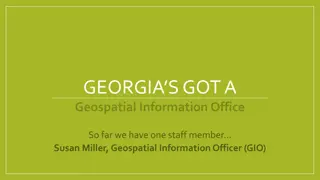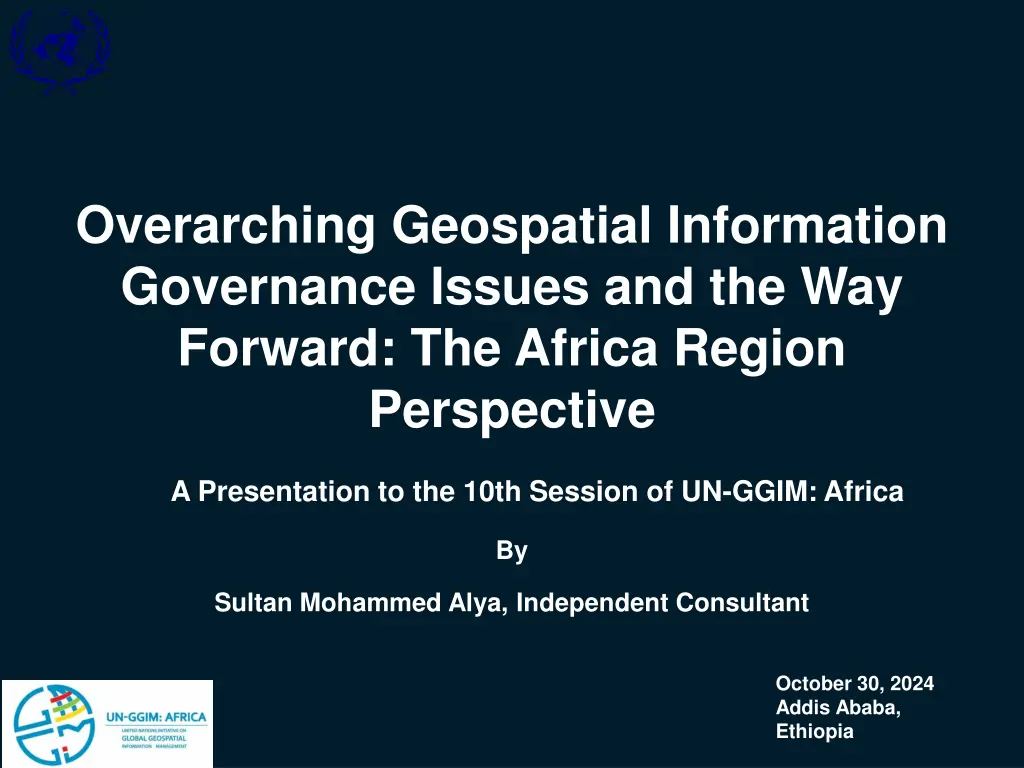
Geospatial Information Governance in Africa
Explore the critical components of Geospatial Information Governance in Africa, its journey to date, overarching issues, and the way forward. Geospatial information plays a pivotal role in various sectors including agriculture, finance, national planning, health, and more. Discover how Geospatial Information is a key component of National Information Infrastructure and its importance in sustainable development, aligned with AU Agenda 2063 aspirations for a prosperous Africa.
Download Presentation

Please find below an Image/Link to download the presentation.
The content on the website is provided AS IS for your information and personal use only. It may not be sold, licensed, or shared on other websites without obtaining consent from the author. If you encounter any issues during the download, it is possible that the publisher has removed the file from their server.
You are allowed to download the files provided on this website for personal or commercial use, subject to the condition that they are used lawfully. All files are the property of their respective owners.
The content on the website is provided AS IS for your information and personal use only. It may not be sold, licensed, or shared on other websites without obtaining consent from the author.
E N D
Presentation Transcript
Overarching Geospatial Information Governance Issues and the Way Forward: The Africa Region Perspective A Presentation to the 10th Session of UN-GGIM: Africa By Sultan Mohammed Alya, Independent Consultant October 30, 2024 Addis Ababa, Ethiopia
Content Content GI: A Critical Component of the National Information Infrastructure (NII) 01 02 GI Governance Defined 03 African GI Governance: Journey To Date 04 African GI Governance: Overarching issues 05 African GI Governance: Way Forward
GI: A Critical Component of NII GI consists of digital spatial data in the form of: Spatially related information used to answer where? questions is commonly referred to as Geospatial information (GI). GI accounts for >80% of the information we use. Geodetic Reference Points (GRP), Maps (point line area data), Images (Aerial photos, Satellite images), Elevations (Digital Elevation Models/Digital Terrain Models), Associated attributes (alphanumeric data related to points, lines, areas, etc)
GI, a critical component of NII: Everything Happens Somewhere Political/ Administrative: International, Regional, National and Local boundary delineation; Election services. Education: Facilities Planning, Instructional/learning aids , Location of institutions National Planning: Economic Planning, Statistics, Population and Housing census, Demographic studies Health: Locations of Epidemic Hot Spots; Prevention and Forecasting; Health Facilities Planning and Distribution Agriculture:Precision Farming, Cultivation inventory, Vegetation cover, Soil study, River dams and irrigation Finance:Revenue generation, Customs and Immigrations, Taxation Land Use: Land Use planning, monitoring, mapping, and administration; Urban planning and development Local Government: Taxation, land use, land records, urban development, utility services. Environment: Environmental Inventory & Monitoring; Flood, Erosion, & Desertification Monitoring; Natural Habitat Conservation; Transport & Communication: Roads & Railways design, Aeronautic Charts for Navigation, Surface Modelling for Communication, National Security: Defence, Crime monitoring and prevention, Search and Rescue operations, Logistics planning.. Culture and Recreation: Facilities Planning, Geo-referencing of historical sites, Cultural Preservation and Sports Development. Energy: Oil, Gas, Hydropower & Wind power exploration, Power Generation, Transmission, Distribution & Monitoring. Tourism: Road network maps and street guides, Tourist attractions and Hotel locations (Tourist Maps).
GI and Sustainable Development: AU Agenda 2063 Aspirations Goals High Standard of Living, Quality of Life and Well Being for All Citizens Well Educated Citizens and Skills revolution underpinned by Science, Technology and Innovation Healthy and well-nourished citizens Transformed Economies Modern Agriculture for increased productivity and production Blue/ ocean economy for accelerated economic growth Environmentally sustainable and climate resilient economies and communities A Prosperous Africa, based on Inclusive Growth and Sustainable Development United Africa (Federal or Confederate) Continental Financial and Monetary Institutions are established and functional World Class Infrastructure crisscrosses Africa An Integrated Continent politically united and based on the ideals of Pan-Africanism and the vision of African Renaissance Democratic values, practices, universal principles of human rights, justice and the rule of law entrenched Capable institutions and transformative leadership in place An Africa of Good Governance, Democracy, Respect for Human Rights, Justice and the Rule of Law Peace Security and Stability is preserved A Stable and Peaceful Africa A Peaceful and Secure Africa A Fully functional and operational APSA African Cultural Renaissance is pre- eminent Africa with a Strong Cultural Identity Common Heritage, Values and Ethics Full Gender Equality in All Spheres of Life Engaged and Empowered Youth and Children An Africa whose Development is people driven, relying on the potential offered by African People, especially its Women and Youth Africa as a major partner in global affairs and peaceful co-existence Africa takes full responsibility for financing her development An Africa as a strong, united, resilient and influential Global Player and Partner
Geospatial Information (GI) industry is a multi- billion and growing industry Projected GI Industry Market Size in Billion Dollars The Geospatial Information (GI) industry is a multi-billion and growing industry. However, the share of Africa in this market is a miniscule 2.7%. 1340.5 646.96 512.5 439.2 2020 2023 2025 2030
Content Content GI: A Critical Component of the National Information Infrastructure (NII) 01 02 GI Governance Defined 03 African GI Governance: Journey To Date 04 African GI Governance: Overarching issues 05 African GI Governance: Way Forward
Governance Defined Governance is about: establishment of policies and regulations, and the continuous monitoring of their proper implementation. It encompasses: decision-making, rule-setting, and enforcement mechanisms 1 What is governance? Governance is the process of making and enforcing decisions within an organization or society Therefore, Governance is only meaningful when policies and regulations have been formulated, adopted and enforced. 2
Content Content GI: A Critical Component of the National Information Infrastructure (NII) 01 02 GI Governance Defined 03 African GI Governance: Journey To Date 04 African GI Governance: Overarching issues 05 African GI Governance: Way Forward
UNECA Member States have been holding meetings on Geospatial Information (GI) since 1961 1961 1997 1999 - 2007 2009 - 2013 2015 - 1 2 3 4 The Committee on Development Information Science and Technology (CODlST) UN Regional Cartographic Conference for Africa The Committee on Development Information (CODl) UN-GGIM: Africa
Summary of Africas journey so far Meetings and deliberations on Geospatial Information (GI) among UNECA Member States ongoing since 1961, Over 60 years up to now. Timeline Create/enhance awareness among African Policy Decision makers and GI practitioners about the role of geospatial information for Africa s development; Develop the capacity of Member States in terms of national geospatial information management policy direction; Establish and promote the necessary institutional arrangements and frameworks that enable Member State to attain an operational level of GIM. Objectives A total of 26 formal meetings were held during the 60-year period: 9 UNRCC, 5 CODI, 3 CODIST, and 9 UN-GGIM: Africa. Meetings Awareness creation regarding the role of GI in sustainable development; Capacity development in various aspects of GIM in Africa; Initiation of valuable initiatives such as AFREF, NSDI/ARSDI, MAFA, etc. Publication and dissemination of various valuable documents to Member States. Achievements All meetings ended with well-structured and well-intentioned resolutions, however, little was achieved in terms of the implementation of resolutions of the meetings. Meetings were reduced to mere talkshows among peers. Shortcomings
Content Content GI: A Critical Component of the National Information Infrastructure (NII) 01 02 GI Governance Defined 03 African GI Governance: Journey To Date 04 African GI Governance: Overarching issues 05 African GI Governance: Way Forward
Geospatial Information Management Agencies or Institutions in most African countries have 3 main issues: 1 Lack of political endorsement at the appropriate level, and hence play limited cross-cutting roles as they are appended to specific functional ministries. Overarching Issues: Governance 2 Lack of adequate institutional mandates 3 Lack of cooperative data sharing environment
Most African countries have no or have outdated GI Policy & Legal Frameworks. Overarching Issues: Policy and Legal
Most African countries lack adequate funding to produce relevant and timely geospatial data and to maintain existing data sets While most developed countries allocate 2-3% of their GDP to Research and Development, African countries only allocate less than 0.5% of their GDP Overarching Issues: Financial As a result, overdependence on foreign donors is widespread
Content Content GI: A Critical Component of the National Information Infrastructure (NII) 02 GI Governance Defined 01 03 African GI Governance: Journey To Date 04 African GI Governance: Overarching issues 05 African GI Governance: Way Forward
Geospatial Information Governance in Africa: The Way Forward VISION MISSION GOALS To provide leadership through formulation of policies, coordination mechanisms, and standards to deliver accurate, reliable and authoritative geospatial information for the attainment of Africa s Sustainable Development Goals and Agenda 2063 objectives. Africa has established effective Geospatial Information (GI) governance structure that enables Member States to produce and utilize timely, reliable, and authoritative GI to support the realization of Africa s integrated and all-inclusive sustainable development goals, and thereby to achieve the digital transformation of Africa. 1. Continental Level Geospatial Information Policy Is Enacted Continental Level Geospatial Information Governance Structure Is Established Africa Has Committed Appropriate Geospatial Information Funding Mechanisms Africa Has Adopted An Effective Geospatial Information Advocacy And Communication Strategy Full implementation of IGIF by African countries Fostering Innovation and Continuous Improvement 2. 3. 4. 5. 6.
To make progress, we need to take a novel approach Let's stop talking only to ourselves! We need to start engaging the political leadership/policy decision makers in the continent. Engage Geospatial information should be regarded as other forms of information that are widely recognized and appreciated by the political leadership/policy decision makers. Demystify Africans take full responsibility for financing our development Goals (AU Agenda 2063: Goal 20). Be Self- Reliant
Attain high level political endorsement Strengthen institutional mandates Build a cooperative data sharing environment through a shared understanding of the value of an Integrated Geospatial Information Framework, and the roles and responsibilities to achieve the vision. Recommendation: Governance
Recommended African GI governance structure Africa GI Patron (Head of State/Government) Africa GI Governance Ministerial Council UNECA UN- GGIM: Africa Secretariat UN-GGIM: Africa Executive Bureau Communication and Advocacy WG Policy and Legal Affairs WG Capacity Building WG Fundamental GI Data Themes WG Standards WG Finance WG
Enact or Improve laws and policies associated with, and having an impact on geospatial information management; Proactively monitor the legal and policy environment on the official responsibility for the regulation and production of data, on issues raised by emerging technologies, and on the evolving use of GI Recommendation: Policy and legal Framework
African countries urgently need to draft and implement Geospatial Information Management Policies and Legal Frameworks that are commensurate with advances in technology, especially in the wake of AI, to enable Geospatial Information Agencies in Africa to regulate, produce and share timely and accurate geospatial information to all users. Otherwise, Geospatial Information Agencies in Africa will soon become irrelevant as their roles will be taken over by large high-tech companies with the grave consequence of breaching the sovereignty of our countries and our continent.
Understand the implementation costs and ongoing financial commitment required to deliver sustained integrated geospatial information management Implement the now forgotten Lagos Plan of Action, African Union Heads of State Summits and Science with Africa Conference recommendation (1980) of setting at least 1% of the country s GDP for Research and Development. Recommendation: Financial Identify sources of funding and allocate annual budget, minimizing dependence on foreign donors.
Funding for GI can be pooled from different sources National Government Budget Allocation NGIA Generated Funds PPP Generated Funds GI Financing Pool Development Partners/ Donors
To make progress, we need to take a novel approach Research & Development Expenditure as % of GDP Sub-Saharan Africa had 2.05 trillion GDP in 2022. If only 5% of the 1% of GDP R & D fund can be allocated for GI, Africa can generate over 1 Billion USD annually for GI. Region Africa % of GDP 0.44 OECD Countries 2.96 China 2.4 World 2.63
But How? The recommended novel approach for Geospatial Information governance in Africa 1 2 3 4 5 Establish a committee for Geospatial Information Advocacy in Africa UNECA AU UNGGIM: Africa Academia Private Sector Identify and contact influential leaders that can champion GI promotion in Africa UNECA UNGGIM: Africa Executive Bureau Prepare a Policy Brief with focus on: Importance of Geospatial Information in guiding Policy formulation & implementation; Expound role of GI in SDGs and AU Agenda 2063 implementation, (Quick wins); Demonstrate with tangible evidence. Present the Policy Brief to the identified leaders/cha mpions Gain the support of the Identified Leaders to recommend to African Heads of State to hold a special conference to establish an Intergovernmental Mechanism (Conference of Ministers equivalent to StatCom Africa) for Geospatial Information Management in Africa.



